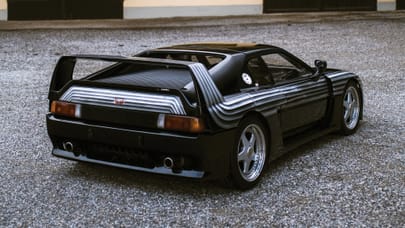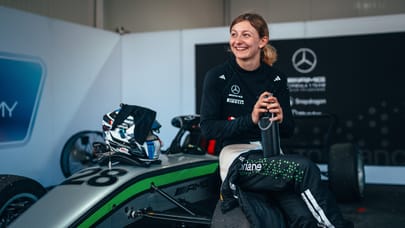
Top Gear's coolest racing cars: McLaren MP4/4
The perfect racing car? We look back at the all-conquering McLaren of 1988


Movie screenwriter William Goldman once said that, in Hollywood, ‘nobody knows anything… every time out it’s a guess and, if you’re lucky, an educated one.’ Motorsport is largely an engineering and scientific discipline, so Goldman’s law simply shouldn’t apply. Yet it often does.
Sometimes, though, the stars align to spectacular effect. In creating 1988’s MP4/4, McLaren found itself at a once-in-a-generation intersection of technical genius, turbocharged firepower, and divine driving talent. Three names stand out: Gordon Murray, Honda, and Ayrton Senna, all at the peak of their considerable powers.
Photos: Wilson Hennessy
Advertisement - Page continues below
Nobody pushed the envelope further than Murray. In fact, the genial South African wouldn’t have been happy until the envelope had been pared to its efficient, practically non-existent essence, a trick he’d recently applied to 1986’s Brabham BT55. That car had a minimal frontal area, groundbreaking aero, and a reduced centre of gravity, but gremlins in its BMW four-pot hobbled it. Murray brought his low-slung chassis philosophy with him when he arrived at McLaren in 1987, while team boss Ron Dennis was negotiating to replace the ageing TAG-Porsche power unit with championship-winning Honda engines (leaving Williams in the cold). With Senna switching to McLaren from Lotus, the stage was set for one of the most perfectly choreographed performances in sporting history.
Turbocharging was to be banned from the 1989 season, but rather than fading away and focusing on the new 3.5-litre V10, Honda’s RA18E twin-turbocharged 1.5-litre V6 was a monumental last hurrah. New rules for ’88 had reduced the fuel tank to 150 litres, and turbo boost pressure was lowered from 4.0 bar to a mandated 2.5, changes that should theoretically have favoured McLaren’s non-turbo’d rivals. Instead, the Honda unit’s compact size worked perfectly in the chassis, and was mounted so low that a new gearbox had to be developed. ‘You have carte blanche,’ Ron Dennis said. ‘Anything you don’t like, change. Anything you want, you can have.’

Murray, chief designer Steve Nichols and aero man Bob Bell reduced the MP4/4’s frontal area as dramatically as they could, extended the wheelbase, and simplified the rear wing. The result was as sleek and elegant an F1 car as there’s ever been, so low that the drivers were semi-recumbent inside it. Senna’s teammate Alain Prost grumbled about the driving position, but changed his tune when he realised how much potential the new McLaren had. According to Murray the team could have gone even further, but chose to ‘to build with lots of wheel travel, sacrificing a little downforce by not running the car too close to the ground. That made it more comfortable and easier to set up.’
No kidding – here was the perfect racing car, visionary in design, in the hands of the world’s two best drivers, run by a team on the cusp of greatness. Only a mistake by Senna in the Italian GP – he tripped up over Jean-Louis Schlesser’s Williams as he attempted to lap him – and an engine failure for Prost in the same race prevented McLaren from winning all 16 rounds of the 1988 World Championship. Thankfully, the domination was offset by the growing rivalry between Senna and Prost, the Brazilian’s desire to win seemingly at all costs bitterly at odds with Prost’s silky driving style and less combative personal philosophy.
Advertisement - Page continues below
Remember Senna’s qualifying lap at Monaco, a performance of such scary brilliance even he talked of driving in a way that was ‘beyond his conscious understanding’? We sure do. He was two seconds faster than anyone else, including his bemused teammate, who did his best to rationalise it. ‘Ayrton’s pole time was fantastic. But you have to take risks for a lap like that and I am not prepared to do that so much any more,’ Prost said. ‘I want to drive all the time if I can at 95 per cent. Maybe for one lap I will use 99 per cent…’ Senna’s Herculean effort would ultimately go unrewarded; he later crashed his McLaren into the barrier near the entrance to the tunnel. Prost went on to take his fourth consecutive win at Monaco...
Senna prevailed in the end, of course, just edging the Frenchman to take the first of his three world championships. But in this instance, the car was as much the star as the men who raced it. And given who they were, that’s really saying something.
McLaren MP4/4

Year: 1988
Designed by: Gordon Murray and Steve Nichols
Drivers: Ayrton Senna, Alain Prost
Engine: Honda RA168E, twin turbo, 1494cc, V6, 900bhp
Transmission: six-speed manual
Weight: 540kg
Stand-out moment: Senna’s pole lap at MonacoHead back to TopGear.com next Monday for the second instalment
Trending this week
- Car Review
BMW 1 Series







